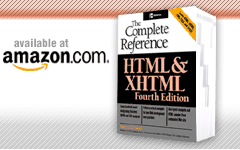ruby
This Microsoft-specific proprietary element is used with the rt element to create annotations or pronunciation guides for words and phrases. The base text should be enclosed in a <ruby> tag; the annotation, enclosed in a <rt> tag, will appear as smaller text above the base text.
Syntax (Defined by Microsoft)
ruby
accesskey="key"(5)</ruby>
class="class name(s)"(5)
contenteditable="false | true | inherit"(5.5)
dir="ltr | rtl"(5)
disabled="false | true"(5.5)
hidefocus="true | false"(5.5)
id="unique alphanumeric identifier"(5)
lang="language code"(5)
language="javascript | jscript | vbs | vbscript | xml"(5)
name="string"(5)
style="style information"(5)
tabindex="number"(5)
title="advisory text"(5)
... base text ...
<rt>ruby text</rt>
Events Defined by Internet Explorer
onactivate, onafterupdate, onbeforeactivate, onbeforecut, onbeforepaste, oncut, ondrag, ondragend, ondragenter, ondragleave, ondragover, ondragstart, ondrop, onfocusin, onfocusout, onhelp, onlosecapture, onmouseenter, onmouseleave, onmousewheel, onpaste, onpropertychange, onreadystatechange, onscroll, onselectstart
Element Specific Attributes
- name
- Sets a name for the ruby base text.
Example
<ruby>This is the base text within the ruby element
<rt>This is the ruby text, which should appear in a smaller font
above the base text in Internet Explorer 5.0 or higher.
</ruby>
<ruby>Base Text
<rt>Ruby Text</rt>
</ruby>
Compatibility
XHTML 1.1
Internet Explorer 5, 5.5, 6
Notes
This element works only in Internet Explorer 5.0 and higher.
The ruby element must be used in conjunction with the rt element; otherwise, it will have no meaning.
At the time of this edition's writing in 2003, this element should be used only in an Internet Explorer-exclusive environment because other browsers will not interpret it or the rt element yet, despite the rise of the Ruby module for XHTML 1.1.


